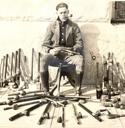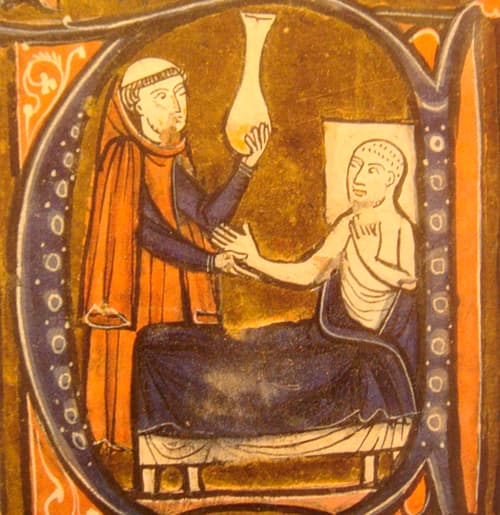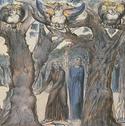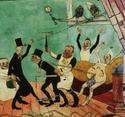Secular medicine in the modern age is driven by the “technological imperative” (if it can be done, then it must be done), and operates within a culture that has replaced the ancient Judeo-Christian anthropology (implicit in the biblical reference to the Imago Dei) with the post-modern concept of radical personal autonomy devoid of any obligations to a Creator.
In many ways, secular medicine has enabled post-modern man to exist as if he were his own God. Post-modern man, with the assistance of medical technology, has uncoupled the connection between sex and procreation through contraception, abortion, and in vitro reproductive techniques, including IVF, pre-implantation genetic screening, “savior siblings,” and surrogate mothers, launching our culture into a new era of eugenics in the process. Many medical and pharmaceutical therapies developed to treat disease are now being utilized to enhance or augment the normal human state.
This has been most evident in the abuse of anabolic steroids among professional and amateur athletes. In the future, the potential benefits of neurotropic drugs will tempt many healthy individuals to use pharmacologic enhancement to improve all forms of cognitive activity. In the area of biomedical engineering, the fusion of man and machine is well underway. Cochlear implant technology, a therapy that has been marvelously successful for providing otherwise deaf individuals with the ability to hear, has been the prototypic model for this class of medical interventions. There has been rapid proliferation in the use of similar devices such as deep-brain stimulators to treat certain neurodegenerative movement disorders, and use of these devices to treat certain psychological disorders is currently under investigation. Similar technology is also being used in the development of eye implants to provide sight in certain forms of blindness.
These opportunities understood within the context of the New Evangelization have the potential over the long term to revolutionize the delivery of authentic Catholic health care for future generations of the faithful, and ultimately for all God’s children.
Is it likely that our society will be able to resist the temptation to use these technologies to augment or enhance normal human sensoria and cognition? What part will professional medicine play in the proliferation of these biomechanical enhancements? If science fiction becomes reality, to what extent do the obligations of the physician to attend to the suffering of his/her fellow man extend to the cyborg? How does the Christian health care professional give witness to the Imago Dei within a society based on such an impoverished secular anthropology?
The pontificates of John Paul II and Benedict XVI have given the post-modern world in general and the Church in particular a new language with which to proclaim the ancient truths of the faith. This new language, now commonly referred to as the Theology of the Body, has much to teach us about the human person in light of a proper Christian anthropology and, given time, can transform first the Church and subsequently the larger culture. Its potential to impact our understanding of health and medicine is limitless and just the right prescription to address much that ails the post-modern world, especially as it applies to our understanding of marriage and family.
In the United States, our ability to proclaim this gospel message will depend in part on the degree to which those in positions of power observe and respect our God-given freedom to practice our faith without governmental interference as it is enshrined in our constitution’s First Amendment. Unfortunately, many of our founders’ assumptions regarding the common good based on Natural Law principles have not fared well in the arena of modern jurisprudence. Legal positivism (which assumes that the existence and content of law depends on social facts and not on its merits) is now the rule of the land. Likewise conflicts between modern society’s understanding of radical personal autonomy as represented by a patient’s request for a legal medical service, and a medical professional’s personal obligation to follow the dictates of his or her conscience regarding what is in the best interest of the patient, are not likely to be resolved to the satisfaction of the conscientious objector.
The prognosis for sustaining a right of conscience in a society that has rejected the principle of absolute truth (to which our inalienable rights are ordered) is not good. The rescission of the 2008 Leavitt Health and Human Services (HHS) Rules granting extensive conscience rights to all health care professionals and institutions by current HHS Secretary Sibelius in 2010 is a case in point, and holds little hope for any meaningful statutory protection for conscientious objection for the foreseeable future (Allott & Bowman, 2009). Given this prognosis, the Christian health care professional must consider the possibility of voluntarily (or perhaps involuntarily) practicing his or her art outside the confines of the current government-controlled system (whether this control is exercised through entitlement financing or legislative/executive mandate).
Going Off the Grid
This brief essay will explore some of the models that have been or are being developed that may allow the practitioner to provide morally licit care to his/her patients without the frustrations imposed by our current private insurance-based system, or the threat of coercion through government-reimbursed entitlement programs.
The “Boutique” Catholic Clinic
With the full implementation of the Affordable Care Act by 2014, it is likely that many medical practitioners will seek to operate outside the system to avoid onerous government oversight and progressive decreases in state and federal entitlement program reimbursement. These “boutique” outpatient practices do not bill private insurance or government subsidized programs, and operate exclusively on monthly premiums paid by the patients in exchange for immediate access to a physician’s services. This assumes that these patients have the financial wherewithal to take advantage of the benefits of Health Savings Accounts (or other similar vehicles) to offset medical expenses and carry catastrophic insurance to cover major hospitalizations. Unfortunately, most of these models are not designed to maximize care to the poor, and are often criticized for exclusively targeting the well-to-do.
Recent success in sustainable boutique practices incorporating charity care as an integral part of the practice is worthy of note. St. Luke’s Family Practice Clinic in Modesto, CA, has been open since 2006 (Forrester & Heck, 2009). Drs. Forester and Heck reserve 50% of their daily appointment slots to treat the uninsured population of the surrounding county. Every effort is made to refer those who qualify for existing state or federal assistance programs to the proper agencies, but for those who fall between the cracks, St. Luke’s will treat and follow them. All the uninsured are seen either the same or next day.
The uninsured side of the practice is underwritten by a group of “benefactors” who pay monthly fees for the unrestricted services provided by the two staff physicians. Benefactors have confidential on-line access to the office calendar, and can schedule appointments on their own, often being seen the same day if they desire. They have immediate access to physicians by way of e-mail or cell phone. These patients sign on for these services knowing in advance that their monthly fees support the charity work that is provided by this non-profit Family Practice.
Office overhead is kept to a minimum since there is no insurance or entitlement billing. The physicians do all their own charting, in one of their two-office/ examination rooms. Both Catholic physicians practice in accordance with the Ethical and Religious Directives, and credit the success of this unique venture to the power of faith and the importance of daily prayer in sustaining their vocations. Since St. Luke’s Family Practice opened in 2006, five similar practices have been established elsewhere in the US. This model has proven to be a viable alternative to a more traditional for-profit practice for the faithful Catholic physician, and deserves a more widespread consideration by those Catholics entering the field of medicine. To that end, Dr. Forester has presented this model of practice at the Annual Meeting of the Catholic Medical Association, and has begun to receive invitations to speak to medical student groups throughout the country.
The Consecrated Health Care Professional
The Church and the nation will be forever indebted to the selfless service rendered by so many women religious, who built an entire network of Catholic hospitals across the North American continent during the 19th and early 20th centuries. The demise of these religious orders and the fate of the hospital systems they founded have been well documented. But a new day is dawning. Not long ago, it was commonly believed that the vocational traditions of the Church were a relic of the past. The workings of the Holy Spirit through the long pontificate of John Paul II are beginning to change the landscape. The effects of this “New Evangelization” have begun to staunch the loss of vocations and new clerical and lay orders are being established both here and abroad. It is inevitable that some of these groups will have as their mission the care of the sick.
One of these orders worthy of mention is the Religious Sisters of Mercy founded in Alma, Michigan, in 1973 at the nadir of the post-conciliar decline in vocations. They currently operate three Mercy Health Care Clinics (Alma, MI; Jackson, MN; and Breuberg, Germany) and have 41 women trained in the health care professions. This includes 11 physicians and 4 current medical students.
Another order dedicated to protecting the sacredness of all human life is the Sisters of Life, founded by Cardinal O’Connor in 1990. The Sisters of Life offer assistance to women dealing with crisis pregnancies, and hope and healing to those who suffer following the tragedy of abortion. The Sisters also provide Catholic medical students an opportunity to deepen their commitment to a culture of life by volunteering at their Visitation Mission Center in New York City (Spaminato, 2013).
The Missionaries of Mercy (MoM) are a canonically approved ecclesial family founded by Fr. Scott Francis Binet, OC. The purpose of this organization is “to witness to the Divine Mercy in word, deed, and sacrament for the salvation of souls through serving the neediest of the needy in man-made and natural disasters.” Fr. Binet’s vision is to grow the Missionaries into a Catholic Doctors without Borders. The first MoM clinic opened in Haiti in 2012.
The Catholic Rest Home Revisited
In the next two decades the pressures of an aging population on a health care system already strained to the breaking point will likely result in mandated rationing of care to the elderly. These demographic realities will be further exacerbated by the ever-increasing breakdown of family structure in the West, leaving the state rather than the extended family as the caretaker for many abandoned elderly. The risk that passive as well as active euthanasia in this context will be seen as a solution to this elder crisis is all too real. The Right to Die Movement has made significant inroads in State legislatures across the country, largely fueled by a sense of radical personal autonomy and personal fears of becoming a “burden.”
The Church is obligated to respond to this crisis in ways that go far beyond political and cultural advocacy. Several of the lay faithful have begun to step forward to serve the needs of the abandoned and underserved elderly, providing environments in which their lives are appreciated and in which the Holy Spirit can work through them until the very moment they are called to meet their Creator.
Nan and Don Weber perceived this need in their Texas Panhandle community and opened Loreto of the Plains home in 2009. Their mission is to “provide Catholic Healthcare at the end of life by creating an environment where Medical and Spiritual Care are united to bring God's hope and peace through ministering to the sick and terminally ill and their family in the light of the Gospel message.” Their not-for-profit home can accommodate three residents and one guest, and operates on a combination of monthly fees paid by the residents and their families, and donations. They accept no government subsidies. Both husband and wife have nursing backgrounds, with supplemental services being provided by a team of trained volunteers. Similar facilities are currently being planned in the Diocese of Dallas and Oklahoma City.
Care of the demented patient requires specialized services that are often beyond the means of many standard nursing home facilities. One faithful Catholic that has responded to this demand in a manner that integrates clinical care with the spiritual needs of the patient is Ann Marie Hanson in Minneapolis, MN (Wiering, 2009). She has opened her non-profit Gianna Home, a private facility in a residential neighborhood that is dedicated to skilled memory care of the demented patient. The home is named after St. Gianna and designed to “honor God, nurture family, and foster friendship.” She currently is working with a local developer to open a small community of Memory Care Homes that would also include Memory Day Care services for elderly whose primary caregivers are working and Child Care services for the skilled employees serving the elderly.
The utilitarian ethic in the setting of Hospice Care is an area of increasing concern to the Church. The waning stages of existence of the terminally ill can be viewed as senseless outside the Church’s understanding of the sanctity of life until the moment of natural death. In a utilitarian context, ending the life of one suffering from terminal disease may be considered a humanitarian act. Passive forms of euthanasia to include voluntarily withholding nutrition and hydration in concert with “terminal sedation” techniques to hasten death are probably more common than generally admitted.
Karen Bussey of Lansing, MI perceived the need for a more holistic approach to the care of the terminally ill based on the understanding of the inherent dignity of the dying person (Horning, 2011). She is a consecrated virgin who was called by God to provide “a place where people who had no family or hospital care could go to be cherished and treasured.” With the assistance of the local diocese she opened Mother Teresa House in 1997 shortly after the passing of the patroness for whom the home was named. Hospice nurses visit the residents as needed, but volunteers provide round-the-clock care, working 3-6 hour shifts to complete a 24-hour cycle of care. Volunteers are required to exhibit a “willingness to be with a sick person, to learn to sit with the suffering face-to-face, knowing that the person being cared for is dying… challenging them to set their daily cares aside so that they can focus on the guest they have come to serve.” Ms. Bussey operates the facility in full compliance with the ethical and religious directives of the USCCB.
Casa USA: Continuing the “Work” of Padre Pio
The divisions between certain segments of the Catholic community and the hierarchy over the Sanctity of Life were nowhere more apparent than during the battle to pass the Affordable Care Act. If one did not perceive the depth of this divide before this crisis, the apparent collusion between certain Catholic health care trade associations and the current administration to pass the bill was enough for most orthodox Catholics to conclude that these Catholic organizations had lost their way. The complex fiscal web in which Catholic institutions now find themselves, particularly in light of the HHS mandate, underscore the need to build anew institutions that are grounded on the fullness of the truth embodied in the Church’s teaching regarding human dignity and the sanctity of life.
Jere Palazollo is an accomplished hospital administrator who perceived this need long before the crisis surrounding the Affordable Care Act arose. His life’s work is now focused on building a network of clinics, a teaching hospital, and a medical school modeled on Padre Pio’s Casa Sollieva della Sofferenza (Home for the Relief of Suffering) in San Giovanni Rotondo, Italy (Pallazollo, 2012). St. Pio, a well-known stigmatist and mystic, is buried in San Giovanni on the site of the hospital which he considered his life’s “work.” Mr. Palazollo’s organization, Catholic Healthcare International (CHI), has signed a collaborative agreement with the original Casa to work together to establish a Casa USA here in North America. It was St. Pio’s vision that these facilities would be founded all over the world to continue the healing mission of our Savior here on earth. CHI is committed to operating all its facilities in a manner that is completely faithful to the teachings of the magisterium. Its first clinic has opened in the diocese of Lexington, KY, and plans for additional nearby clinics, the hospital, and the medical school will be implemented over the next five to ten years.
Conclusions
These opportunities understood within the context of the New Evangelization have the potential over the long term to revolutionize the delivery of authentic Catholic health care for future generations of the faithful, and ultimately for all God’s children. We should not entertain the delusion that this larger transformation will occur anytime soon. In the meantime, as we await this re-enculturation, the Church must prepare to subsist and flourish outside the cultural mainstream. In the words of First Things editor R.R. Reno, we may be awaiting the imposition of a New Dhimmitude; a softer version of the second-class status of citizenship that Islam imposed on conquered Christian societies during the period of Muslim expansion (Reno, 2013).
But any attempt to force orthodox Christian physicians and other Christian health care professionals out of our government-controlled medical system will ultimately fail in its purpose to suppress our ability to proclaim the Church’s vision of human dignity. It will merely displace those who are committed to remaining faithful to the Church beyond the control of the Secular Ascendancy. This will likely mean significant sacrifices in the way of remuneration and professional status for those called to the healing ministries. But these are small concessions indeed for those called to follow the Divine Physician in his work to heal the sick and attend the suffering of His people.
References
Allott, D. & M. Bowman, “The Right of Conscience in the Age of Obama,” American Spectator, November 2009, pp. 22-27.
Forrester, R.A. & R.J. Heck, “What You Can Do to Help Your Uninsured Patients,” Family Practice Management, October 2009, pp. 21-24.
Spaminato, C. & E. O’Donnell, “Living Faith and Medicine,” Linacre Quarterly, February 2013, p. 3.
Horning, B., “A House of Peace and Love,” Columbia Magazine, January 2011, pp. 19-20.
Wiering, M., “Gianna Homes Founder Strives to See Person, not Disease,” The Catholic Spirit, September 2009, pp. 3b-5b.
Reno, R.R., “The New Dhimmitude,” First Things, April 2013, pp. 10-15.
Pallazollo, J., “Padre Pio’s Hospital in Kentucky,” Catholic Health Care International Newsletter, Summer/Fall 2012.
Dr John I. Lane is Professor of Radiology at the Mayo Clinic School of Medicine in Rochester, MN, and currently serves as President of the National Catholic Medical Association. He graduated from the University of Scranton, and received his MD from Jefferson Medical College in 1985.



